Arethusa Falls
Plenty of water, all we need now is some cold. Please!
Arethusa Falls
Crawford Notch NH – 12-6-2015
At nearly 200 feet high, it is the highest waterfall in NH
Arethusa Falls
Crawford Notch NH – 12-6-2015
At nearly 200 feet high, it is the highest waterfall in NH
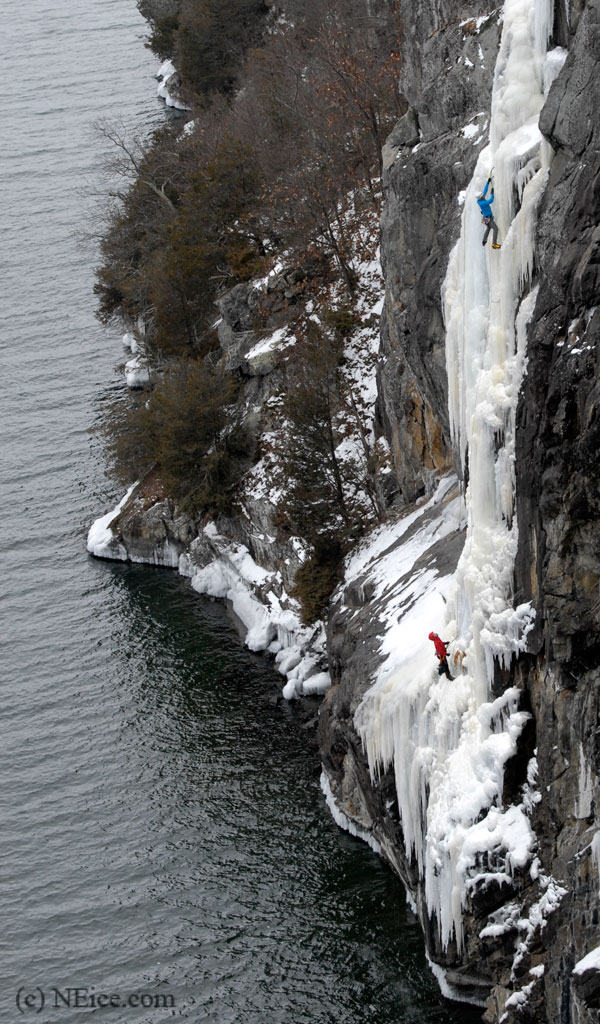
Kevin Mahoney on ” The Lake Champlain Monster”. Alden Pellett keeping one eye on Kevin and the other for the Lake Monster.
Kevin Mahoney and Alden Pellett having fun escaping from “The Monster” during a midday break from their gear demo responsibilities at The 19 annual Adirondack Mountainfest.
*Photos by Doug Millen
Kevin Mahoney – Mahoney Alpine Adventures
The Mountaineer – Keene Valley NY
Times like these don’t come along often, I mean, when was the last “Polar Vortex”? But when they do, you better be ready. The conditions were ripe for the picking last week on Whitehorse & Cathedral Ledges, North Conway NH. Peter Doucette – Mountain Sense Guides – along with IMCS guide Sam Bendroth, Erik Eisele, and Adam Bidwell had “Mountain Sense” and dropped everything to take full advantage of these rare conditions. With plenty of ground water and a “Polar Vortex” to bring in some great “Streaks”, they hit the jack pot.
Peter had a few days of training earlier at Cathedral Ledge before his Whitehorse rampage. And as Bayard said, “Peter, now fully warmed up and ready for the next event, takes it to the next level. In the next three days he proceeds to climb everything. I mean everything!” See more on Peter’s warm up from NEice Ambassador Bayard Russell of Cathedral Mountain Guides on his Blog Post Sending Streaks
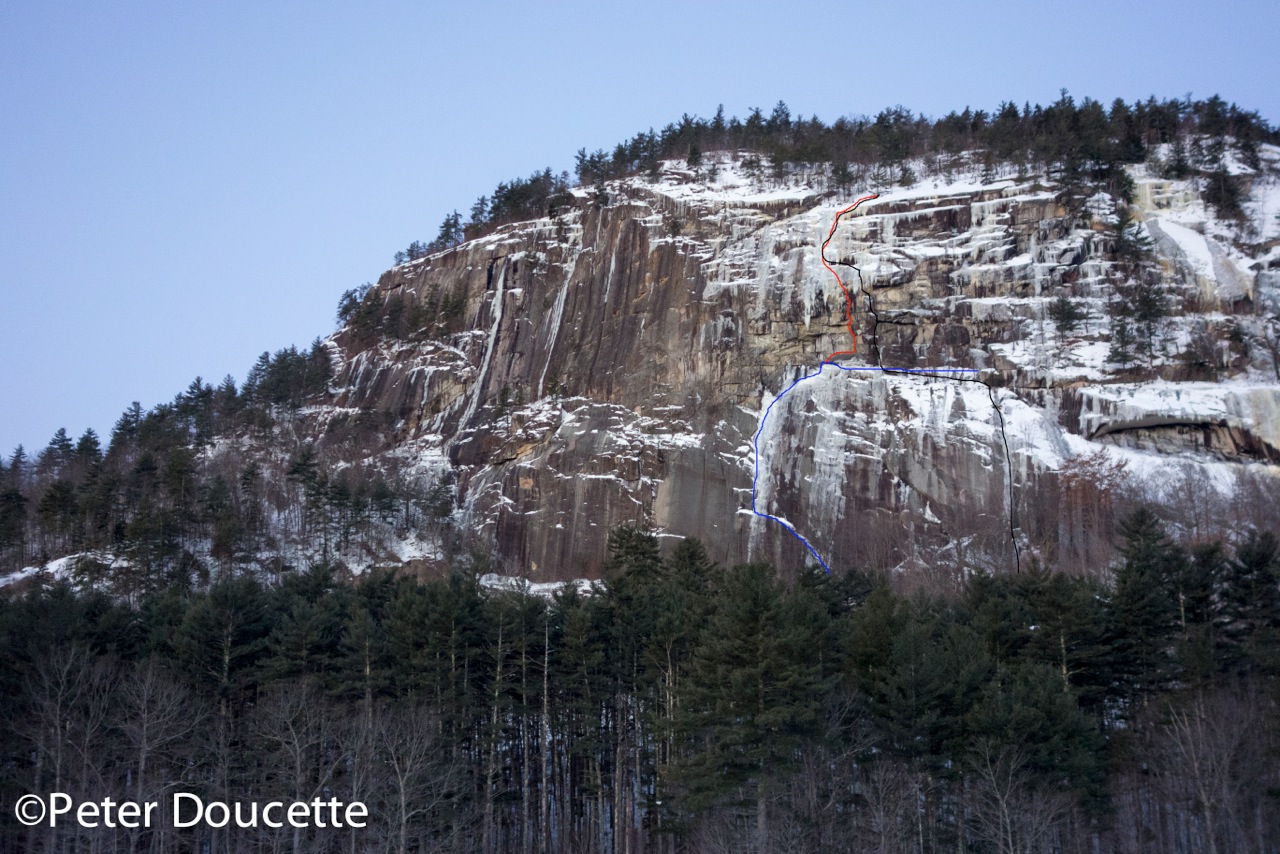
Whitehorse Ledge – South Buttress, North Conway NH / Blue is Endangered Species, Black is “Ice Devil” and Red is the “Reckless Youth” finish to “Endangered Species”.
“Taking a page out of the Russell/McCormick play book, during the nearly unrelenting deluge today, Erik and I followed “Endangered Species”, (Webster/Winkler ’82) and branched out on a slight variation to get into the Children’s Crusade finish up ice glazed corners yielding “Reckless Youth” (M8 WI5+) shown in Red.- Peter Doucette
” We were soaked to the bone, used umbrellas for the approach and first belay, and reached the ground just as a thunderclap ripped through the valley. Pete led the crux pitches, one and three, both of which were incredible to watch. On the Eradicate Dike he was looking at huge falls into ledges, and in the upper corner he was climbing a six inch vertical smear while clipping bad fixed pins. It was raining so hard water filled my boots. I went through four pairs of gloves. To watch Peter work in such conditions was pretty amazing.” – Erik Eisele
“Ice Devil” (WI5+ M6+) shown in blue, followed a smear right of the rock route “Seventh Seal”, up “Scare Tactics,” then angled left into the upper reaches of “Beelzebub” with some variations. Brilliant climbing both days, full conditions today. Who know’s what will form in the next couple weeks if the “Polar Vortex” kicks back in.” – Peter Doucette
The Myth offered some rare and spectacular climbing.
” The Myth with the absent top-out sadly apparent from below…sometimes you have to see it in person to believe it :-)” – Peter Doucette
The routes are as follows:
So all I want to know, when is the next “Polar Vortex” due? – Doug Millen
IFMGA/AMGA Licensed Mountain Guide
Related Stories
Peter is guiding Ice Climbing 101 on FRIDAY and Outdoor Research’s Steep Waterfall Ice on SATURDAY at this years Mount Washington Valley Ice Fest !
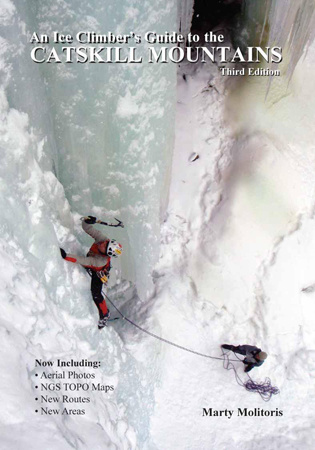
An Ice Climber’s Guide to the Catskill Mountains, Third Edition
An Ice Climber’s Guide to the Catskill Mountains, Third Edition
The exclusive and detailed guide to ice climbing in the Catskill Mountains of New York, by Marty Molitoris.
Third Edition Now Including:
Aerial Photos in both color and black & white
Color National Geographic Topographical Maps
Over 170 New Routes
8 New Areas!
ISBN 978-0-9747067-3-3
Retail: $29.95
For more information, please visit AnIceClimbersGuideToTheCatskillMountains.com
Pick up a copy of An Ice Climbers Guide to the Catskill Mountains at the following locations:
Rock & Snow
44 Main St
New Paltz, NY 12561
845-255-1311
www.rockandsnow.com
Alpine Endeavors – Ebay
You may also be interested in The Devil is in the Details

by Courtney Ley
The Great Gulf. There could be no other name for it. When I look at it from the vantage point of Mt Clay, I imagine the walls of this giant cirque begin to expand suddenly, high rocks and cliffs start breaking apart and tumble into its gaping mouth. I see the summit of Mt. Washington tilting, the buildings shake and crumble, sliding into the dark abyss with deafening sound. All that’s left is a giant cavern. The Great Gulf just swallowed Mt. Washington whole.
But as I stand on the summit of Mt. Clay on this day, all is still. The only moving object is the sun as it lowers over Franconia Ridge to the west, creating long shadows across the Presidential Range. I hear no tumbling rocks or collapsing cliffs. I only hear the sound of the wind beating on my jacket. I am alone and feel at ease. I watch the sky turn pastel colors and soft lenticular clouds form high above me. I adjust my hood to block the wind the best I can and head down the mountain towards Sphinx Col.
My need for seclusion brought me to the Great Gulf. Some approach the gulf from Huntington Ravine and do it in March or April when the gulf is filled with the years snowfall and travel is relatively easy. I had two days and decided to approach it from its beginnings. I wanted to wind my way through its endless water courses and forest canopies. It’s not very far in miles, but the wilderness trails are left to the forces of nature. The trees fallen across paths remain in place and water is not forcefully diverted away. Long bogs and difficult river crossings are a norm here. I enjoy the wilderness feel, as it’s hard to find in the developed White Mountains of New Hampshire. The Great Gulf is by no means ‘out there’. A quick jaunt up the Chandler Ridge finds you at the Auto Road and once you top out of the headwall, there’s Mt. Washington’s summit with its restaurant and gift shops. The Great Gulf Wilderness was conceived in 1964 and is New Hampshire’s oldest yet smallest wilderness area, comprising just 5,658 acres. Despite this, the giant glacial cirque leaves you feeling like you are somewhere remote and far away from anyone and anything.
Admittedly, I also had another motive. I was hunting down ice and I had a good feeling I’d find some here. Not only is the gulf at a high elevation but it’s predominately north facing and it’s walls rarely see sunlight. It had the elements necessary for early season capture. I pitched my tent at one of the designated tent sites along the Great Gulf Trail and set out. Unlike other ravines, the gulf doesn’t show its full self until you are just about at its walls. The spruce are tall and the tiny Spaulding Lake proves the only vantage point from the floor during this time of year. When I worked my way around the lake I got a glimpse of ‘Wait Until Dark’ Gully. It begged me forth. I knew reaching the entrance would be no easy task. I was proved wrong, it was much harder than I imagined. Giant truck-sized boulders were scattered among thick spruce. Enormous crevasses littered themselves between boulders. The terrain was so difficult I couldn’t fathom enough snow falling to fill it all in. I thought about turning around several times, but each time I dreaded going back more than I dreaded continuing forward. It took me almost two hours from once I left the trail until I crawled to the start of the ice begging for mercy.
My spirits lifted when I saw the gully filled with beautiful solid ice. For a full length pitch, I enjoyed a continuous flow of grade 2 ice. I fell into my rhythm of swings and kicks, focused solely on ice in front of me. Occasionally, some ice would break loose and fall away, echoing as it hit into the rocks. A reminder of the vast amphitheater that I was climbing in. At times, the wind would funnel down the gully, picking up snow and swirling it in a cold dance towards me. I lowered my head and let it pass each time. The wind tried to push me backward, as if I did not belong. But I knew I did, at least for this brief while. A short steep step led me to the upper ice which was at a lower angle with a few short bulges. I stopped more frequently here and took in my surroundings. Eventually the ice relented to a rock and vegetation finish. I hit the Mt. Clay summit loop trail immediately when I topped out, as it hugs the lip of the gulf.
I never saw anyone all day and nor would I during the night and majority of the next day. Now I stood on the summit of Mt. Clay with no one else in sight on the ridge. I sat down in a wind-sheltered area and looked back at where I had come from. I couldn’t think of my time in the gulf spent any other way. It had granted me my solitude. It was as it was meant to be. I imagined the entirety of the Great Gulf as it expanded, shuttered, and devoured the nearby peaks. I imagined the Great Gulf as it swallowed me too.
Photographs by Courtney Ley (click on images to enlarge)
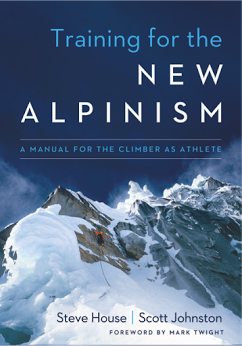
Training for the new alpinism
In Training for the New Alpinism, Steve House, world-class climber and Patagonia ambassador, and Scott Johnston, coach of U.S. National Champions and World Cup Nordic Skiers, translate training theory into practice to allow you to coach yourself to any mountaineering goal.
“Training for the New Alpinism is a manual that guides you in constructing a simple, progressive training program lasting from six weeks to a year and beyond. The book has been heralded as a road-map to greater alpine climbing success for climbers of all abilities”
Get a copy here
The calm before the storm and another beautiful day in the alpine zone. One week earlier Doug and I enjoyed the “calm” with entirely different conditions in Madison Gulf. This time we experienced mid March weather on February 22.
Enjoy and get ready for the long days of March.
Alan Cattabriga
by Ryan Stefiuk
I buried my face inside my puffy coat as Andre’s snowmobile lurched into motion. The rubber tread beneath us occasionally slipped on the thick black tiles of ice as we sped along the pond. To my right, Alden and Walt were cruising along, closer to the shoreline. The Cholesterol Wall, looming just above them, is bathed in the most wonderful, soft orange evening light. The sky is deep blue overhead, and the air is warm and windless. A few minutes later we’re crossing the community woodlot and nearing the trailhead. The sun, the lone figure in a brilliant cloudless sky, is setting over the ocean to the west. No amount of illicit mind-altering substances could induce the trip I’m having right now.
Newfoundland is a land of extremes. The drive from New England is long, boring, and almost always includes awful weather while traveling through Nova Scotia. Our 7-hour ferry crossing from Nova Scotia to Newfoundland has been delayed more times than it’s been on schedule. The ferry routinely gets stuck at sea. The “puke fests” that ensue are legendary. One women told us it was so rough during one of her crossings that water was spilling out of every toilet on the boat as it rocked for 18 hours off the coast of Channel-Port aux Basques. They spent days bleaching that boat afterward. The warm ocean currents from the Gulf Stream and the Gulf of St. Lawrence make the weather fickle and windy. It can snow a foot or two in a day, but if it’s windy there won’t be any snow on the ground, anywhere. It can be -20 degrees for days straight, or it can be 45 degrees for your entire trip. If you’re lucky, you’ll climb 5 days on a 10-day trip. It’s probably better to expect 2-4 days of climbing during that time and if the weather sucks you might not climb at all. Black Horse Lager will be a good friend.
The people are friendly, hospitable and inquisitive. Each oceanside town is small, with only a few hundred year-round residents. None of them are climbers, but many of them are familiar with the fjords and they’re ringers when it comes to driving their Ski-Doos. Finding your way into the fjords can be as easy as saying “hello” at the general store or restaurant and asking if there’s anyone who’s willing to show you the way into the “ponds” (sounds more like “pand” – Newfoundlanders slaughter vowels like nobody’s business).
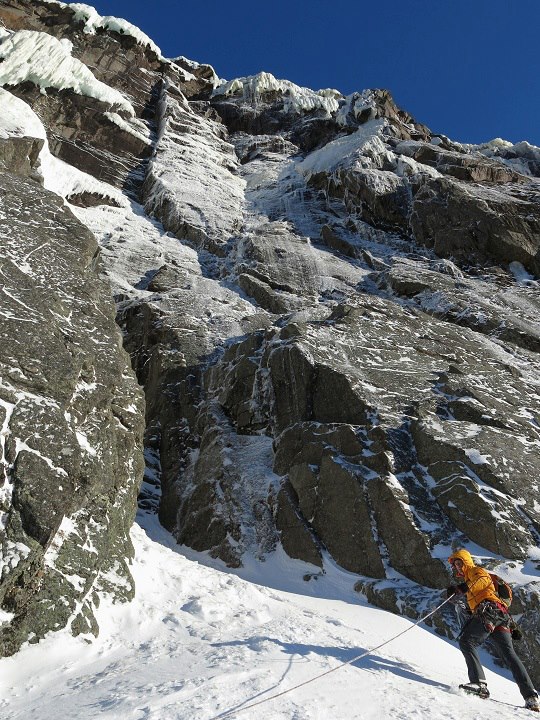
Ryan Stefiuk preparing for a trip up Stratochief, which climbs the weak groove up the face, before traversing right to a corner system that breaks the giant overhangs above. Photo – Alden Pellett
There are several fjords or “inner ponds” – they’re easy to spot on any topographic map and on Google Earth. I’ve spent hours, maybe days, pouring over maps of the west coast and there’s a lot to look at. Unfortunately, access to nearly all of the fjords is extremely challenging during most winters. The inner ponds don’t freeze regularly in all but one fjord. Fortunately, this pond has the most impressive array of climbs most ice climbers have ever seen. Ten Mile Pond is home to mega-classics like Fat of the Land (WI5+, 950′), Weather Vein (WI5, 1600′), Stratochief (WI5+, 700′), and He Speaks for Rain (WI6, 1000′). Each of these routes is insanely classic and ranks among North America’s finest. To have nearly two dozen of these routes in one place speaks worlds of this venue’s quality. To put things in perspective for the average New England climber – take Lake Willoughby and triple it’s height, and then cross it with Cannon Cliff, and you have Ten Mile Pond Cliff. It is that good.
The crown jewel of Ten Mile Pond is the Cholesterol Wall. The C-Wall, as it’s known by Joe Terravecchia and Casey Shaw, who’ve established most of the routes, is a 300 meters wide, yet houses a dozen classic lines ranging from 500-950′. This wall is backcountry ice cragging at it’s finest. At 8-miles from the nearest road, it’s no place to screw up, and there are no routes easier than WI5+ on this wall, but each route is pure bliss on a nice day. On a heavy weather day it feels like Alaska during a bad storm. During this trip, by the end of one day there was 4 feet of new snow on the ledges. Two cold and windy days later that snow was entirely gone; I don’t know where it went but it wasn’t there.
Seeing is believing, and I’ve seen enough to be convinced that Newfoundland may be North America’s finest ice venue. So, if you don’t mind a long, heinous drive in bad weather, an even more heinous ferry crossing, really cold windy weather or torrential rain and you can lead WI5 in 5 degree weather miles from roads, people and with no real potential of being rescued you will be rewarded with some of the world’s finest ice climbing. Oh hell, even if you don’t climb super hard there’s a lifetime’s worth of climbing there. The beauty of the place is that there’s no guidebook – you’ll just need to explore like every other climber who’s visited the west coast has done.
Even though some areas in Gros Morne National Park have reasonable access there is no management plan regarding ice climbing there. It’s a privilege to climb there and it should be considered an “alpine” climbing area, like any other mountain region. If you can’t climb your route without bolts, leave it for future generations to climb. Leave the drill at home.
Ryan Stefiuk / NEice Ambassador
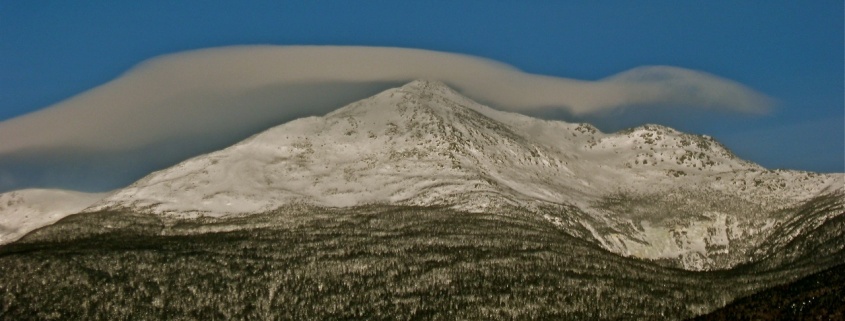
The Eastern aspect of Mt. Adams and the ice of Madison Gulf (lower right) Click image to make larger.
The Great Gulf is a massive area shroud with mystery. In the early years of hiking for many of us here in the White Mountains, the huge drainage of the West Branch Peabody River, the “Great Gulf Wilderness” was a place filled with intrigue. The remote drainage with its many tributaries, gulfs & ravines holds something almost lost to us here in the New Hampshire. And is a place that harbors silence and a true feeling of being alone. Experiencing this area in summer or winter, total responsibility for one’s actions is paramount. This is especially true during the winter months. However, it is during this time when one perceives the rare peacefulness that resides here. A peacefulness so complete, a single bird singing a short song goes right to the heart. During all of my time spent out in the winter months, I try to mimic the quiet of this season. A small and perhaps vain attempt at keeping human noise out no matter where I am. Often I think to myself, this is what goes on, all the time, when I am not here. I’m just a blip on the screen in this environment and attempt to have my passage go unnoticed.
On the East Face of Mt. Adams, glowering above Madison Gulf resides a cliff. The ice that hangs in various lengths and hues of psychedelic colours off this wall offer wonderful climbing in a wilderness setting. At the end of a day your body will be tired and the mind satisfied with all it had seen. This is especially true if the summit of Adams is reached after the ice climbing is over. Madison Gulf is a climbing area that will not appeal to everyone. The approach and descent, the weather, ice and the mountain itself are all ingredients that make this a very satisfying day for those that come here.
I’ve been into the Gulf many times, via both aspects of approach, the East and the West. For the past four years my preferred approach is from the West via the Valley Way Trail in Randolph. Not only is this way going to be packed to the col, it’s skiable and lends itself to summit Adams as a finish to the climbing and subsequent descent. My last time in via the Great Gulf/Madison Gulf Trails in 2009, took 7 hours just to get to the ice. It was a beautifully epic day that opened my eyes to put away the guide book and approach from another direction, one that made sense to me. Check out the Post here.
Milage to the ice, with ether choice is close. However the time may not be. The Western approach, the Valley Way is ~4.7. The Eastern, Great Gulf/Madison Gulf trails about ~5.3. The key to the approach for the Great Gulf Trail is a lean snow year or early season. Alternatively, catching the Valley Way tracked to the col. can happen almost anytime. To each their own, I’ll not say one is better than the other, it all depends on what you seek. The Valley Way is faster and can have complete solitude, that is if you leave early enough. It also has the wonderful terrain of the Madison-Adams col. The beauty of Star Lake and passing the craggy Parapet en-route to the descent could be a destination in itself. The Great Gulf Trail feels remote after the first bridge. The river sings almost throughout the entire hike and you’ll pass through some of the states most beautiful forest and countryside.
Saturday, February 16, 2013
The day after an excellent session of lift service skiing, Doug and I are on the Valley Way Trail. In a few hours we are at the Madison-Adams col. The fog and stillness join together to create an eerie, though appealing environment. Our view of the ice from the Parapet is not available for fog is dropping like a heavy veil over the mountains face.
I kept the descent on the high side, not wanting to get drawn too low. And though the visibility and snow conditions were less then perfect, in little time we came to the northern most route, Point du Pinceau. A traverse along the base brought us to our destination. The line of Point is the longest on the cliff. This is the best route to do if one is not rappelling and continuing on by ether traversing off via the Buttress Trail back to the col or upward to the summit of Adams, Point gets you closer to both of these two exits.
The ice is perfect. The large flow was a cascade of movement caught and frozen in a kaleidoscope of colours. We climbed side by side until a headwall of steeper ice at one third height. Here we climbed through a weakness one at a time. Above, the ice was like an azure sea with islands of white sand. It flowed upwards, lapping like the tide into a green mainland of stunted trees.
The snow through the trees was airy and deep, snowshoes were once again required. After crossing the Buttress trail which runs from Star Lake down into the Great Gulf, we continued up an unseen mountain looming above. Part way to the summit the snow became firm and the rime iced rocks more exposed. We stopped in the surreal landscape, packed the snowshoes and took a tea break. The fog was thick and the wind light and we took the wonderful atmosphere into our souls.
The summit came to us like the face of a wraith out of the fog and after a quick handshake we were off. The Airline Trail drops off the top and after a half-mile merges with the Gulfside Trail. We followed this back to the col and flowed like liquid back down the Valley Way.
Reanimating areas and climbs is my passion. I look at Madison Gulf as a challenging way to summit Mt. Adams. The unusual weather we had, the constant changing of ice and conditions made this another wonderful experience. Grades did not matter and without any expectations of what lay before us, this was about experiencing an amazing area and climbing a mountain, pure and simple.
Another great link-up when the snow is just right is that of King Ravine to Madison Gulf. Here is the link to a post from 2009. Link
Thanks to all for taking the time to read this. And thank you to Doug for being there.
[nggallery id=30]

Your ice climbing connection for New England, the Northeast and Beyond!
